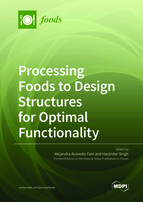Processing Foods to Design Structures for Optimal Functionality
A special issue of Foods (ISSN 2304-8158). This special issue belongs to the section "Food Physics and (Bio)Chemistry".
Deadline for manuscript submissions: closed (30 October 2021) | Viewed by 35243
Special Issue Editors
Interests: understanding structures; interactions and functions of food proteins; food emulsions, encapsulation, protection and delivery of bioactive compounds in foods and food formulations
Special Issues, Collections and Topics in MDPI journals
Interests: relationships between the food structure; digestion and release of nutrients and bioactive compounds; encapsulation of active food ingredients; strategies to develop future food systems with better nutrition value
Special Issues, Collections and Topics in MDPI journals
Special Issue Information
Dear Colleagues,
Foods are formed in nature through the complex assembly of macromolecules that interact to form hierarchical structures. These structures are transformed by processing. Traditional food processing is designed to preserve, destroy, and re-create food structures to develop desirable food products and functional food ingredients. For example, whole foods such as meat, fish, nuts, fruits, and vegetables undergo minimal processing in order to preserve their natural structures. On the other hand, the controlled destruction of natural structures results in a variety of ingredients, including starches, flours, oils, and protein isolates. These ingredients are then reassembled and transformed into various fabricated foods. Interactions of food components and the creation of appropriate structural characteristics are achieved through processing operations such as thermal treatment, homogenization, and shear, as well as microbiological or biochemical transformations. In recent years, these approaches have led to the concept of “food structure design” as a new way of guiding food product development, particularly in relation to the development of foods with reduced levels of fat, salt, and sugar. Efforts have also been made in restructuring plant-based materials to develop meat and dairy analogues with acceptable product functionality.
In this Special Issue, we invite papers that deal with our understanding of the impact of food processing (conventional and novel processing) on the structures and interactions of food components and how these structures/interactions can be optimized to enhance the functionality of food products. We welcome high-quality submissions from research scholars working on the topics listed below:
- Influence of conventional and novel processing technologies on food material interactions and functionality.
- Structuring food materials through processing and formulation technologies to reduce salt, sugar, and fat content.
- Processing of plant materials to create new structures that mimic meat and dairy products.
- Relationships between ingredient interactions, food structure, and sensory aspects of foods.
Prof. Dr. Harjinder Singh
Dr. Alejandra Acevedo-Fani
Guest Editors
Manuscript Submission Information
Manuscripts should be submitted online at www.mdpi.com by registering and logging in to this website. Once you are registered, click here to go to the submission form. Manuscripts can be submitted until the deadline. All submissions that pass pre-check are peer-reviewed. Accepted papers will be published continuously in the journal (as soon as accepted) and will be listed together on the special issue website. Research articles, review articles as well as short communications are invited. For planned papers, a title and short abstract (about 100 words) can be sent to the Editorial Office for announcement on this website.
Submitted manuscripts should not have been published previously, nor be under consideration for publication elsewhere (except conference proceedings papers). All manuscripts are thoroughly refereed through a single-blind peer-review process. A guide for authors and other relevant information for submission of manuscripts is available on the Instructions for Authors page. Foods is an international peer-reviewed open access semimonthly journal published by MDPI.
Please visit the Instructions for Authors page before submitting a manuscript. The Article Processing Charge (APC) for publication in this open access journal is 2900 CHF (Swiss Francs). Submitted papers should be well formatted and use good English. Authors may use MDPI's English editing service prior to publication or during author revisions.
Keywords
- Food structure
- Ingredient interactions
- Food functionality
- Conventional processing
- Salt/sugar reduction
- Fat reduction
- Plant-based foods
- Novel processing








